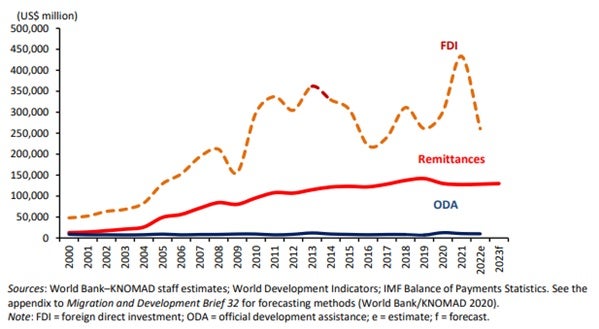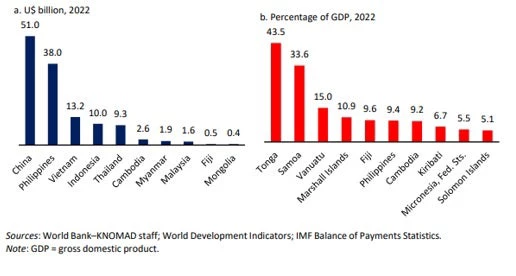 Nursing staff at Tonga's largest hospital
Nursing staff at Tonga's largest hospital
After declining for two years, growth in East Asia’s remittances turned mildly positive (0.7 percent) in 2022 although, if China is excluded, remittance growth in East Asia was more vibrant at 3.8 percent in 2022. In 2021, remittances grew at 5.5 percent. Officially recorded remittance flows to East Asia in 2022 stood at $130 billion of which East Asia’s share excluding China (share of 39 percent) was $79 billion. In 2022, after China, the largest recipients were the Philippines ($38 billion)and Vietnam ($13 billion).
Remittances composed the second-largest resource flow in East Asia after foreign direct investment (FDI) which has been high and volatile since 2008. Between 2021 and 2022, FDI dropped by 40 percent, pushing up the ratio of remittances to 50 percent of FDI. This ratio was only 29 percent in 2021 when FDI was much higher. With the graduation of most East Asian countries from low- to lower-middle-income status, or from lower-middle to upper-middle-income status, the flow of official development assistance (ODA) was negligible in 2022.
Domestic and host economy conditions jointly shaped remittance flows in East Asia in 2022. Longer-term trends such as structural shifts and FDI-enabled economic diversification, prosperity, demographic change, and the associated labor dynamics led China, Malaysia, and Thailand to assume dual roles as (1) origin countries for relatively skilled migrants departing to high-income countries of the Organisation for Economic Co-operation and Development (OECD), and (2) destination countries for less-skilled migrants from within East and South Asia.
Resource Flows to the East Asia and Pacific Region, 2000–23f
Remittance flows to the Philippines – the largest recipient after China in the East Asia and Pacific region – grew at about 4 percent to reach $38 billion in 2022, relative to $36.7 billion in 2021. This increase benefitted from a lifting of the ban on emigration to Saudi Arabia due to the abusive treatment of workers, and specific deals forged by the Filipino government, especially in new OECD destinations. Growing at 5.2 percent in 2022 compared with about 19 percent in 2021, remittance flows to Vietnam registered $13 billion in 2022. Remittances to Indonesia grew at nearly 6 percent to reach $10 billion in 2022. They measured $2.6 billion in Cambodia. Remittance growth decreased sharply in both Malaysia and Thailand, which serve as host and home countries for migrants.Remittance growth in Malaysia was only about 5 percent in 2022 compared with 10 percent in 2021,and 3 percent in Thailand in 2022 relative to 10 percent in 2021.
Historically, remittances have been of vital importance to the East Asia and Pacific region’s smaller countries, with Tonga and Samoa featuring regularly in the list of the top 10 global recipients of remittances as a share of gross domestic product (GDP). In 2022, remittance receipts measured 44 percent of GDP in Tonga and 34 percent in Samoa. The corresponding figure was 15 percent for Vanuatu and 11 percent for the Marshall Islands (figure 2.2). The Philippines and Cambodia are distinct among the larger East Asian countries, with remittances amounting to more than 9 percent of GDP.
Top Remittance Recepients in the East Asia and Pacific Region, 2022
The average cost of remitting $200 to the region decreased to under 3 percent in the top five least expensive corridors (figure 2.3), achieving the SDG target in 2022. Between 2021Q4 and 2022Q4,among the least expensive corridors, the reduction in the cost of remitting to the Philippines was the greatest. Among the most expensive corridors, the cost of money transfers from Thailand to several countries within East Asia increased.
Read the latest Migration and Development Brief here.



Join the Conversation